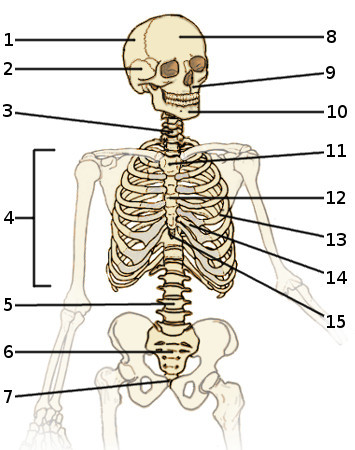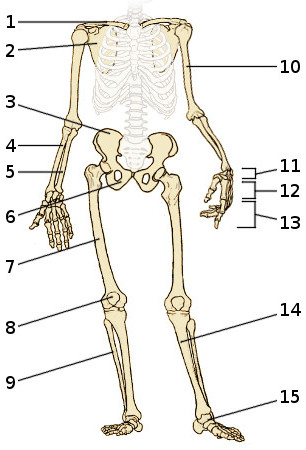What is the difference between the axial and appendicular skeletons?
Test your knowledge of the axial and appendicular skeletons by answering the following questions, and if you don't know the answers then read the text below to find out.
1. The skull is part of the ________ skeleton.
2. There are _________ thoracic vertebrae.
3. The five fused bones at the base of the spine are called the ________.
4. The shoulder girdle is part of the ___________ skeleton.
5. The thoracic cage is part of the ____________ skeleton.
6. There are _________ pairs of ribs in the thoracic cage.
7. The pelvic girdle is part of the _____________ skeleton.
8. The sternum is part of the ____________ skeleton.
What is the difference between the axial and appendicular skeleton?
The axial skeleton is the core of the skeleton, and provides attachment for the appendicular skeleton. It includes the eight cranial bones of the skull, thirteen facial bones, the hyoid bone, the vertebral or spinal column (seven cervical, twelve thoracic, five lumbar, five fused sacral vertebrae and the four to five small fused vertebrae of the coccyx), the rib (or thoracic) cage consisting of twelve pairs of ribs (seven fixed or true ribs and five false ribs) and the sternum (or breastbone). Fractures in the axial skeleton are more serious than in the appendicular skeleton.
The appendicular skeleton attaches to the axial skeleton, and includes the four bones of the shoulder girdle (the scapulae and clavicles), the two bones of the pelvic girdle (the ilium and the iscium), the arm bones (the humerus, radius, ulna, eight carpals of the wrist, five metacarpals and fourteen phalanges of both arms) and the bones of the legs (the femur, tibia, fibula, the seven tarsals of the ankle, the five metatarsals and fourteen phalanges on both legs). Fractures in the appendicular skeleton are more common than in the axial skeleton.


The axial and appendicular skeletons
Resources :
In this section we've added a few alternative study aids to help you along.
- Articles - Here you'll find a range of short articles on basic anatomy and physiology topics, complete with a few 'test yourself' questions for each one.
- Images and pdf's - Just in case you get tired of looking at the screen we've provided images and pdf files that you can print out and use for 'off-line' practice.
- Word Roots - When you learn the word roots, prefixes and suffixes contained within anatomical and medical terms, you can often work out what they mean. This can be a useful skill as you progress in your studies, so we've provided a dictionary to help you!
- Games - Finally in the resources section, we've added some simple games to make anatomy and physiology practice a little bit more fun.



